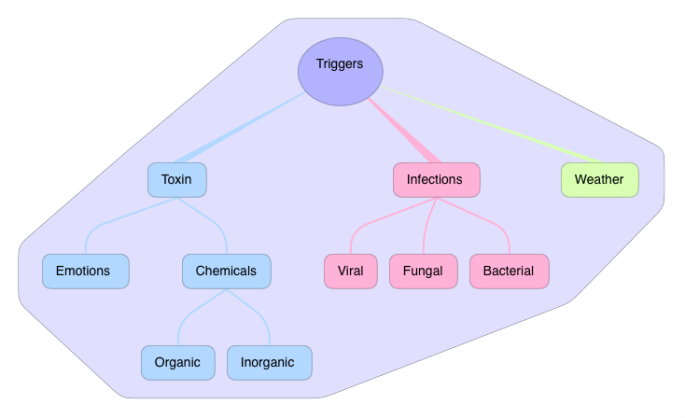Ardavan virtual body veritable body
LEVEL 1
At the first Level, the Virtual body is equal to the Veritable body. The particular symptoms are less important than general symptoms and patient has both. At this level we usually use polycrests as the similimum.
LEVEL 2
At second level, the Virtual body is different from the Veritable body. It is as if the Virtual Body has been limited to one part of Veritable body. In this type of diseases, the patient describes his/her problems saying “My”; he/she does not use “I”. It is as if his/her whole body is focused on this particular part. Usually in this level, we have prominent sensations, modalities and concomitants describing this particular location of the body. Although concomitant symptoms usually occurs in other part, if you pay attention to the body language of the patient, his/her hand moves around the part of body that has problems. For example a patient describing headache attacks, while he/she talks about nausea his/her hand moves around upper part of body and not to stomach area!
LEVEL 3
In third level, the signs and symptoms are so intense in one location of body that it is severely inflamed and the patient is in crises. In this kind of case, although we see sign and symptoms in one location, the symptoms are so intense that the patient use “I”. They express themselves as if both the Virtual and the Veritable bodies were limited to that single location!
Usually in Level 3, we use anti-inflammatory (antiphlogistic) remedies such Bell, Stram, Acon, Op,… We choose our rubrics from the General Section of repertory.
EXAMPLE TWO
Level 1
Another example can be a patient with Rheumatoid arthritis with pain and stiffness in joints and patient feels better in warm weather and wore in cold and has copious sweating and constipation. This patient is in Level 1 and may need Calc-c.
Level 2
If this patient comes with more pain in one joint which is worse in wet weather and motion is agg in the start and amel in continuous motion is in Level 2 and may need Rhus-t.
Level 3
If above patient comes with severe pain, inflammation, heat and redness in one joint may need Belladonna.
EXAMPLE ONE:
Level 1
A patient has skin eczema, asthma, occasional headache, especially during menses. She is cold patient and perspires profusely. This patient is at Level 1 and may need Calc-c. In this patient, the Virtual Body is equal to Veritable body and we do not need to pay more attention to details of particulars.
Level 2
If above patient comes with severe eczema with cracks, bleeding, sever itching, although the patient has head pain during menses and asthma, it seems that Virtual body is not equal to Veritable body and Virtual body has been limited to Skin. That is, the skin symptoms are more pathologically severe than the other symptoms. In this patient, we do not consider other symptoms of the patient. She may need petr., a specific organ remedy.
Level 3
But if the patient comes with severe eczema with severe inflammation, suppuration and discharge (and no other symptoms elsewhere in the body, we should not refer to skin section in repertory instead, we must find our rubrics in general section and this patient may need Merc. This is a Level 3 case.
Key: Px = patient, Sx = symptom(s)
Virtual body and Levels of Pathology progression
Characteristics of Pathological Development
Level 1
Chronic dynamic state (miasmatic, non-miasmatic, case with paucity of symptoms)
Level 2
One sided type A
Level 3
One sided type B
Body types
1.Virtual Body= Veritable Body
Virtual Body limited to one part of the Veritable Body.
Virtual body = Veritable body but both limited to the diseased part
Px language
Both “I” and “my”
“my”
“I”
Sx location
Anywhere
Single
Single
Sx type
Particular sx less important than general sx.
Sensations, modalities, concomitants
Signs and symptoms are very intense and in inflammatory state.
Sx severity
Varies
Prominent but not very severe
Intense single location.
Remedy type
Polycrests (Usually)
Small remedies (Usually)
Anti-inflammatory remedies
Repertory
General (mental and/or general) + particular
Particular
General
This paper is unfinished, but presented it in hopes that members will present their questions and relate the article to our course of study.
From above description it seems that we have two kinds of bodies!
1- Veritable body, which is static and does not change.
2- Virtual body, which is dynamic, and changes according to the progression of disease.
If you pay attention to these levels, you will understand why some master insist on Generalizations and other on Mental, General and some on Location, sensations, and modalities. They are each focusing on a different level of pathological development.
In a homeopathic clinic, we see in some cases pathology is limited to one part of body with non-specific sensations and modalities. In other cases we see symptoms scattered in different part of body. Some of these body locations have sensation and others have modalities, but symptoms are not prominently focused in one location.
While some patients bitterly complain of sign and symptoms focused in one part of their body, oddly, when asked about other problems these patients are reluctant to answer. It seems that their physical complaints are limited to this single location.
We can classify disease progression on three different levels. As disease progresses the level of the disease increases. From Level 1 to Level 3, the territory of VF becomes more limited and VF has to struggle more to expand its territory. With increased pathology, the VF is bound to a smaller area of freedom!




